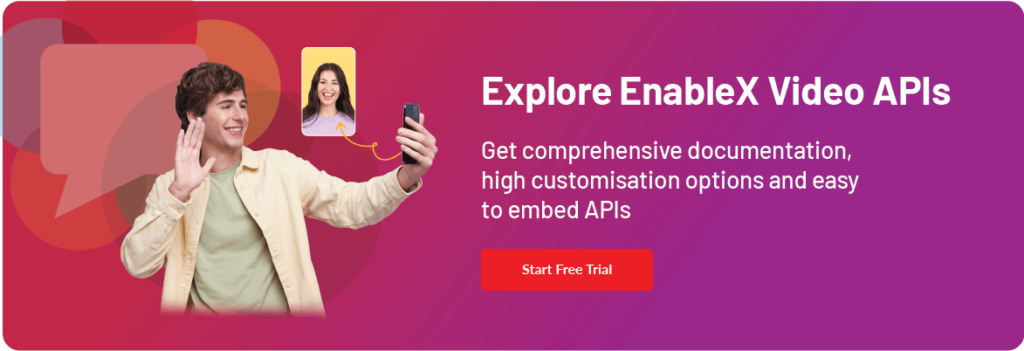In today’s digital age, where online engagement is crucial, integrating a reliable Live Streaming API or Video API into your website can significantly enhance user experience. This article explores the intricacies of Live Streaming APIs, with a special focus on the standout performer – EnableX.
What is Live Streaming API?
A Live Streaming API is a set of protocols and tools that enable the seamless transmission of audio and video content over the internet in real-time. Therefore, this type of application programming interface allows developers to integrate live streaming functionality into their software or platforms, facilitating the broadcasting of live events, presentations, or multimedia content.
The Video API establishes a communication bridge between the streaming server and the application, ensuring a smooth flow of data and enabling users to access the content as it unfolds. Developers leverage Live Streaming API to create interactive and dynamic experiences, fostering real-time engagement with audiences across various digital platforms.
Why Live Streaming API is Important for Websites?
These Video API for live streaming plays a crucial role in enhancing the interactive and dynamic nature of websites. It serves as a vital component that contributes to the overall functionality and user experience on web platforms.
Integrating a Live Streaming API into websites enables real-time communication and content delivery, fostering a dynamic and engaging environment for users. However, this functionality adds a layer of immediacy and connectivity, allowing websites to transcend traditional static content and embrace the dynamic nature of live events.
The significance of video API provider lies in its ability to transform websites into live, interactive spaces through there services that cater to the evolving preferences of users seeking real-time experiences.
How Live Streaming API Works?
Live streaming APIs facilitate the real-time transmission of audio and video content over the internet. These video calling APIs serve as the bridge between the content source, such as a camera or microphone, and the streaming platform.
The process begins with the content source encoding the audio and video data into a format suitable for streaming. The Video API then takes this encoded data and transmits it to the designated streaming server. The server, in turn, distributes the content to viewers in real-time. Authentication mechanisms are often implemented to ensure that only authorized users can access the live stream.
Benefits of Integrating Live Streaming API on Websites
Integrating Live Streaming API on websites offers numerous benefits that enhance user experience and engagement. Here are some key points and paragraphs highlighting these advantages:
- Real-Time Interaction: These Video APIs enable real-time interaction between content creators and their audience. Whether it’s a live webinar, product launch, or a gaming session, users can actively participate by asking questions and receiving instant responses, fostering a sense of community.
- Increased Engagement: Live content tends to capture users’ attention more effectively than static content. However, by integrating live streaming API on websites, businesses can keep their audience engaged for longer durations, leading to increased brand visibility and user retention.
- Wider Reach: Live streaming allows websites to reach a wider audience as it transcends geographical barriers. Users from different parts of the world can access and participate in live events, broadening the website’s reach and potentially attracting new visitors.
- Dynamic Content Delivery: Websites that integrate the video calling API can offer dynamic and diverse content. From live interviews and tutorials to behind-the-scenes glimpses, live streaming adds a layer of authenticity and variety to the content, keeping users excited and coming back for more.
- Monetization Opportunities: Live streaming opens up new avenues for monetization. Websites can implement various revenue streams, such as pay-per-view events, subscription models, or in-stream advertisements. This can be a lucrative strategy for content creators and website owners alike.
- Enhanced User Experience: The immediacy of live streaming contributes to an enriched user experience. Users can witness events as they unfold, creating a more immersive and satisfying experience compared to pre-recorded content. This enhances the overall quality of interaction with the website.
- Social Media Integration: Live streaming APIs often come with features that facilitate easy integration with social media platforms. Moreover, this cross-platform sharing capability enables websites to leverage existing social networks, amplifying the reach and impact of their live content.
- Data Analytics and Insights: Many video API provider have robust analytics tools, offering insights into user behavior, preferences, and engagement metrics. This data can be invaluable for website owners to refine their content strategy, tailor offerings to audience preferences, and optimize overall performance.
Best Live Streaming API – EnableX

EnableX offers a robust and reliable live streaming API that caters to the evolving needs of users. With a focus on delivering seamless and high-quality streaming experiences, the video calling API stands out as a notable player in the live streaming API domain. Sign Up for free trial!
The platform is designed to meet the demands of various applications and industries, providing a versatile solution for those seeking efficient live streaming capabilities. As technology continues to advance, this video API provider remains at the forefront, offering a live streaming API that adapts to the changing landscape of digital communication.
Its commitment to innovation and adaptability reflects in the continuous enhancements made to its live streaming API. The API understands the importance of staying ahead in the competitive realm of live streaming services and, as a result, consistently updates its offerings to align with the latest industry trends.
The user-friendly interface and well-documented Video API documentation contribute to a seamless integration process, making it accessible for developers and businesses alike. Whether used for real-time communication, broadcasting events, or other applications, it’s video API provides a foundation for building dynamic and engaging experiences.
Advantages of EnableX Live Streaming API
- High Performance and Reliability: The Live Streaming API offers robust and reliable performance, ensuring a seamless and uninterrupted live streaming experience. It is designed to handle high traffic volumes and maintain consistent video quality.
- Scalability: The video calling API is scalable, allowing businesses to easily adapt to changing requirements and audience sizes. Whether streaming to a few viewers or a large global audience, this video API provider can scale up to meet the demands, ensuring a smooth user experience.
- Low Latency: One of the key advantages is low latency, providing real-time interaction between broadcasters and viewers. This feature is crucial for applications where immediate feedback and engagement are essential, such as live gaming, auctions, or interactive events.
- Cross-Platform Compatibility: This video API is designed to be compatible with various platforms and devices, including web browsers, mobile devices, and smart TVs. This cross-platform support enhances accessibility and allows businesses to reach a broader audience.
- Customizable Player: The API provides a customizable player interface, allowing developers to tailor the look and feel of the streaming player to align with their brand or application requirements. Therefore, this flexibility enhances the user experience and brand consistency.
- Security and Privacy: This Video calling API prioritizes security, implementing robust encryption protocols to safeguard live streaming content. This ensures that sensitive information remains confidential and protected from unauthorized access.
- Developer-Friendly Integration: The API is developer-friendly, offering comprehensive documentation and support to facilitate smooth integration into existing applications or new development projects. So, this ease of integration accelerates the deployment of live streaming capabilities.
- Monetization Options: For businesses looking to monetize their live streaming content, The API provides features such as pay-per-view or subscription models. This opens up revenue streams and allows content creators to capitalize on their broadcasts.
- Real-time Analytics: This Live Streaming API includes analytics tools that provide real-time insights into viewer engagement, audience demographics, and other metrics. However, this data empowers businesses to make informed decisions and optimize their live streaming strategies.
- Reliable Support and Updates: Businesses using this video API can benefit from ongoing support and updates, ensuring that the API remains compatible with evolving technologies and industry standards.


